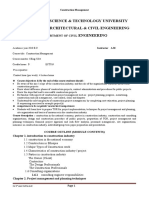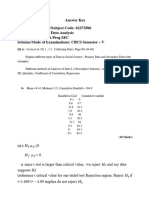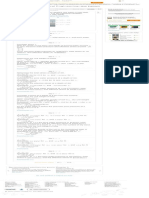For Civil students by G.G
& W.M Page 1
ADDIS ABABA SCIENCE & TECHNOLOGY UNIVERSITY DEPARTMENT CIVIL ENGINEERING
Academic year 2017 E.C Instructor G.G & W.M Year: 4
th
year Semester: I Course title: Specification and Quantity Surveying
Course number: CEng 4111 Prerequisites: CEng3110 (Building Construction), CEng3114 (Computer Aided Drafting / CAD) Credits hours:
3
Contact hour (per week): lecture 2, tutorial 3, LP 0
Course objectives &competences to be acquired:
At the end of the course the student will be able to do :- 1 Analyze the Construction project cycle, processes and the roles of construction stakeholders 2 Explain the different types of specification and understand construction project standards 3 Prepare specifications and Bill of Quantity for different civil works projects. 4 Estimate quantities for all types of material, manpower, and equi
pment’s needed for
construction projects. 5 Compile a Survey data to estimate quantity of civil works and estimate cost of project. 6 Use standard forms of contract, prepare specification and quantity works
COURSE OUTLINE (MODULE CONTENTS)
CHAPTER ONE: General Introduction on the Construction Industry
1.1. Construction project cycle and processes 1.2. Construction Industry 1.3. Construction stake holders 1.4. Resource for Construction Industry 1.5. Construction Management Process 1.6. Ethiopian Construction Industry
CHAPTER TWO: Specification
2.1. Definition 2.2. Purpose of Specification 2.3. Types of Specification 2.4. Specification Writing 2.5. Standard specification for Building for Building, water works and Road Construction
CHAPTER TREE: Quantity Survey
3.1. Methods of Measurement 3.2. Quantity Surveying 3.3. Materials Take Off sheet Preparation and Measuring of Quantities 3.4. Writing Bill of Quantities 3.5. Sub structure and superstructure works 3.6. Quantity Surveying for Building and water works

For Civil students by G.G
& W.M Page 2
3.7. Quantity Estimation of earth work for Roads 3.8. Loose and compacted volume of earth work for Roads
CHAPTER FOUR: Project Cost Estimation
4.1. Introduction 4.2. Factors Affecting Cost Estimation 4.3. Types of Costing or Estimation 4.4. Fundamental approach to construction cost estimation 4.5. Basic Cost Components of a construction project 4.6. Unit Rate Analysis and Cost Break down 4.7. Components of Unit rate Analysis 4.8. Labor productivity, Labor index and utilization factor 4.9. Estimation Methods and Tools 4.10.Preparations of payment certificates
CHAPTER FIVE: Valuation and its Concept
5.1. Introduction 5.2. Types of Valuation 5.3. Valuation of fixed assets 5.4. Valuation of plant and machineries
Teaching &learning methods
Lecturers, Demonstration, tutorial exercises, group discussions
Assessment /evaluation system
Attendance---------5% ,
individual / group assignment) -------15%
continuous assessment( two mid exam) ------------------ 30%
final exam---------------- 50%
Attendance requirement:
students are expected to attend at least 80% for Theoretical Lesson.
Reference
1 John Adriaanse, ‘Construction Contract Law’, Palgrave Macmillan,(2011),
2 Duncan Cartlidge, New Aspects of Quantity Surveying Practice, Butterworth- Heinemann; 2nd editions.
3 Kam Shadan, “Construction Project Management Handbook”, March 2012
4 E.J.Blocher, D.E.Stout & G.Cokins, Cost Management (A Strategic Emphasis), 5th Edition, 2010 5. B.N . Dutt, ( 2008) , Estimating & Costing In Civil Engineering & Practice. 6.M. Chakraborti, ( 2008) , Estimating Costing Specification & Valuation In Civil Engineering 7. BATCODA, (1991), Conditions of Contract. 8. The New specification
For Civil students by G.G
& W.M Page 3
CHAPTER ONE General Introduction on the Construction Industry 1.1.
Construction Project Cycle and Processes
There are many different types of projects, but interestingly, they all have one thing in common.
They all go through the same cycle, known as the
project life cycle
, or project management life cycle.
The project life cycle is made up of five project stages:
Project Initiation
Project Planning
Project Execution
Monitoring & Control
Project Closing.
Each of these phases is necessary
1. Project Initiation Phase
The
start of the project
for the project manager, who is responsible for defining the project at a high level.
business case, feasibility study, cost-benefit analysis
and other types of research
to determine whether the project is feasible or not.
Stakeholders provide input.
If the project is approved, then a
project charter is created
, which
provides an overview of the project
and sets up the stage for your project plan.
2. Project Planning Phase
This phase
begins by setting SMART
(specific, measurable, attainable, realistic, timely)
goals.
The
scope of the project is defined
and a
project management plan is created
,
identifying cost, quality, resources and a timetable.
Some of the features of this phase include
a scope statement, setting of milestones, communication, risk management plans
and a
work breakdown structure
.
3.
Project Executing Phase
For Civil students by G.G
& W.M Page 4
Some tasks that make up this phase include:
Developing the team
and
Assigning resources
using key performance indicators,
Executing the project plan,
Procurement management
and
Tracking and monitoring progress
.
If needed, you can set status meetings and revise the schedule and plan.
4. Project Monitoring and Controlling Phase
This phase consists of
setting up controls and key performance metrics
to measure the effectiveness of the project execution.
It is very important to
and
budget
baselines.
5. Project Closing Phase
phase it’s over.
Completing the deliverables to the satisfaction of your stakeholders
is key. .
That means
closing out work with contractors
, making sure everyone has been paid and ensuring that
all project documents are signed off
on and archived to help with planning future projects. Figure: Production Cycle of Construction Activities



























































































